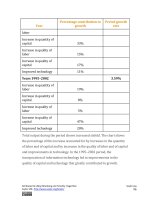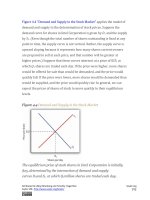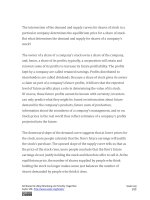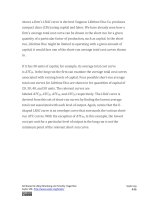Authors libby rittenberg 789
Bạn đang xem bản rút gọn của tài liệu. Xem và tải ngay bản đầy đủ của tài liệu tại đây (415.61 KB, 1 trang )
important lesson of Adam Smith’s idea of the market as an invisible hand,
guiding the economy’s scarce factors of production to their best uses. That
is not always the case, however.
We have studied several situations in which markets are unlikely to
achieve efficient solutions. In an earlier chapter, we saw that private
markets are likely to produce less than the efficient quantities of public
goods such as national defense. They may produce too much of goods that
generate external costs and too little of goods that generate external
benefits. In cases of imperfect competition, we have seen that the market’s
output of goods and services is likely to fall short of the efficient level. In all
these cases, it is possible that government intervention will move
production levels closer to their efficient quantities. In the next three
sections, we shall review how a government could improve efficiency in
the cases of public goods, external costs and benefits, and imperfect
competition.
Public Goods
A public good is a good or service for which exclusion is prohibitively
costly and for which the marginal cost of adding another consumer is
zero. National defense, law enforcement, and generally available
knowledge are examples of public goods.
The difficulty posed by a public good is that, once it is produced, it is
freely available to everyone. No consumer can be excluded from
consumption of the good on grounds that he or she has not paid for it.
Consequently, each consumer has an incentive to be a free rider in
Attributed to Libby Rittenberg and Timothy Tregarthen
Saylor URL: />
Saylor.org
789









